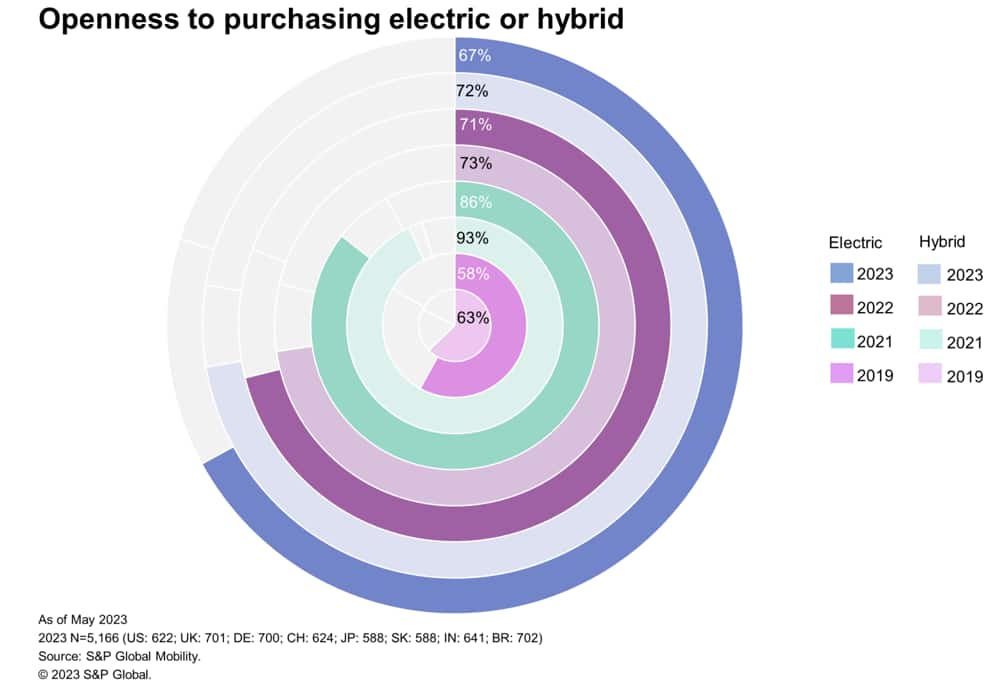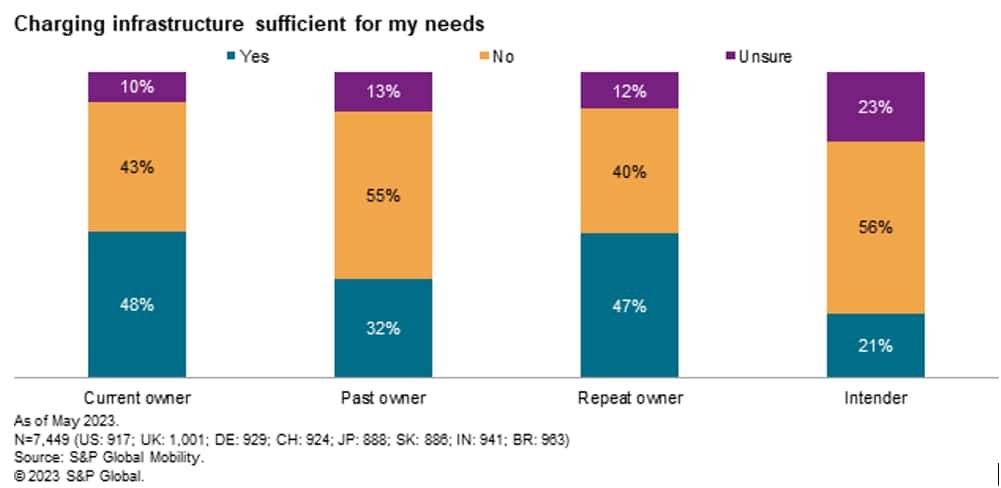
[ad_1]
Though battery-electric automobiles are getting nearer
to cost parity with their inner combustion siblings, the
affordability issue is the primary purpose shoppers are holding again
on adopting electrification, in line with a latest survey by
S&P International Mobility.
Though vary nervousness and the charging community stay causes
to hesitate, a latest world survey of shoppers confirmed that
potential EV consumers are most involved concerning the affect to their
pockets. What’s extra, this isn’t only a US-market phenomenon. It is
affecting shoppers worldwide – even in areas the place EVs have made
important market inroads.
Nearly half (48%) of the 7,500 respondents globally think about EV
costs to be too excessive, despite the fact that they perceive that the majority EVs
inherently carry a value premium.
“Pricing remains to be very a lot the largest barrier to electrical
automobiles,” in line with Yanina Mills, senior technical analysis
analyst at S&P International Mobility.
Client sentiment towards shopping for an EV has cooled significantly
over the past two years. This rise and fall are emblematic of an
immature market section, Mills mentioned. That mentioned, improved electrical
car vary, and the elevated variety of mannequin selections, have
moved down shoppers’ listing of causes to keep away from buying an
EV.
Regardless of an elevated variety of EVs obtainable, and improved
shopper consciousness of tax-credits and advantages, fewer than half of
respondents consider the EV know-how is prepared for mass market
adoption. Solely 42% of respondents are contemplating an EV for his or her
subsequent car buy and 62% of respondents are ready till the
know-how improves earlier than buying a brand new car, the S&P
International Mobility survey discovered.
How issues have modified
Initially, shopper curiosity was smothered by the restricted
number of obtainable EV fashions. Simply 58% of 2019 S&P International
Mobility survey respondents had been open to buying an EV, as
luxury-priced fashions dominated the early EV market. Only a handful
of mainstream fashions, just like the Chevrolet Bolt, Nissan Leaf, and
Tesla Mannequin 3, had been obtainable at the moment.
However 2021 noticed a dramatic burst of shopper EV acceptance. Purchaser
willingness soared, with 86% of worldwide respondents being open to
purchase an EV. A number of components stirred up these good emotions: New
mainstream fashions from Ford, Hyundai, Kia, and Volkswagen hit the
market. The professional-EV push within the US by the Biden administration, and
laws in a number of US states and in Europe banning future
inner combustion-engine (ICE) automobiles, additional heightened
visibility.
Whereas 67% of the 8,000 individuals surveyed in Could 2023 had been
open to the thought of buying an EV – actually increased than in
2019 – it’s a whopping 19 share level decline from 2021.

What occurred?
The final two years have introduced extra shopper alternative. These
span the far ends of the market, from hulking EV pickups within the US
to many small EV selections turning into obtainable in Europe and
China.
For one, value fatigue has set in, pushed by rising curiosity
charges and stock shortages which have solely not too long ago seen reduction,
mentioned Brian Rhodes, director of related automobile and car expertise
for S&P International Mobility.
Relying on the place an EV is manufactured, modifications to the
tax-credit program within the US now drive shoppers to lease – somewhat
than buy – many fashions. Frequent media stories about charging
community reliability shortcomings haven’t helped both. At this
level within the evolution of EVs, including extra fashions merely can not
cancel out these points.
Proudly owning an EV forces some modifications in routine. In comparison with an ICE
car, EV driving vary is usually much less. As soon as the battery
cost is depleted, it takes longer to recharge a battery than it
does to refuel a gasoline tank. Inherent EV drawbacks like these make
shoppers reluctant to purchase, particularly these often making lengthy
journeys. Nevertheless, survey outcomes present that customers settle for dwelling
with an EV’s concessions – relative to an ICE car –
post-purchase.
That mentioned, many EVs bought so far are second – typically smaller
– automobiles within the family. “For these contemplating an EV as their
main automobile, the vary/charging points are amplified since there may be
no various on longer journeys,” Rhodes mentioned.
The charging community
Charging considerations are second solely to car value amongst causes
cited for these respondents in opposition to shopping for an EV. About 46% of
respondents are involved concerning the time required for charging,
whereas 44% are involved concerning the availability of charging stations
– a reversal of causes from final 12 months.
“Customers know (charging) is not going to be the usual gasoline station
in-and-out expertise,” Mills mentioned. “However they do not need to delay
for rather more time than what can be a lunch break.” Certainly, the
plurality of 2023 survey respondents mentioned they had been keen to attend
between half-hour and an hour to recharge.

Assembly this charging expectation requires
each infrastructure funding and car functionality. The one
present know-how that may assist 30-to-60-minute recharging is
quick (DC) charging, so an in depth quick charger community turns into
essential to match shopper calls for. An industry-wide shift in the direction of
utilizing Tesla’s beforehand proprietary NACS charging design ought to
speed up charging community availability if set up charges maintain
up with gross sales.
Likewise, EVs have to have high-capacity built-in chargers that
can take full benefit of quick chargers. For instance, a number of
Hyundai, Kia, and Genesis automobiles have 350kw/800V charging that
can cost a battery from 10% to 80% in 18 minutes – assuming the
charging location is working correctly.
As for the idea of battery swapping, shoppers in mainland
China, India, and Brazil proceed to be most within the
idea – with greater than 75% of worldwide respondents keen to attend
as much as half-hour for a battery swap, at a median value level of
$16.
Residence is not the place the cost is
One widespread grievance in opposition to widespread electrical car
adoption (both battery-electric, or plug-in hybrid) is that
charging is tough for homeowners who do not reside in homes and thus,
haven’t got a charger on-site. However survey outcomes reveal that this
concern could also be overstated.
Respondents confirmed that the most typical – and finest – single
place and time to recharge is certainly at dwelling, at night time. Nevertheless,
solely 42% of householders sometimes cost their electrical car this
method. Moreover, simply 51% of present and repeat EV homeowners have a
charger put in at dwelling. Whereas the {industry}’s widespread chorus is,
“Most homeowners will recharge at dwelling,” barely half of the early
adopters surveyed met that circumstance.
Seems, homeowners cost their automobiles in all kinds of
locations, together with streets, highways, and through work. Amongst EV
intenders, 25% plan to make use of public charging stations (15%).
House owners who do cost at dwelling aren’t in a rush. Most respondents
aren’t keen to pay something further (31% of respondents), or are
keen to pay a minimal 10% further (40% of respondents), to improve
to a sooner Stage 2 charger that takes 5 hours for a full
cost. Customers need quick charging on the highway, however they are going to
wait in a single day for a full cost at dwelling.
Has vary nervousness been cured?
Competing producers have pushed one thing of an EV “vary
conflict,” significantly throughout the luxurious section. The longest-range
Tesla Mannequin S claims 405 miles of vary, whereas the Lucid Air Grand
Touring promotes 516 miles. These luxurious automobiles push the envelope
in each vary and value – the Lucid stickers at almost $126,000 –
however most shoppers have extra modest wants and desires.
Most respondents indicated that they might settle for a minimal EV
vary under 300 miles. 19% would settle for a variety between 251 and 300
miles, whereas 21% can be positive with a variety from 201 to 250 miles.
Solely 29% most well-liked a minimal vary above 300 miles.
Present EV vary capabilities match this shopper demand. Nearly
each EV available on the market has a United States Environmental Safety
Company (EPA) vary of greater than 200 miles. Automobiles with an
estimated vary over 300 miles are restricted to automobiles from luxurious
manufacturers, similar to Lucid, Tesla, Rivian, BMW, and Mercedes-Benz.
Whereas present know-how could be prepared for shopper acceptance,
it doesn’t imply that customers are prepared simply but to make the leap
to an EV. 62% of respondents agreed with the assertion, “I’m
ready till car know-how improves earlier than buying a brand new
automobile.”
Requested about this disconnect, Mills defined, “There’s all the time
that little little bit of ‘What if…’ that continues to carry shoppers
again, even when for probably the most half they know they’re most likely going to
be OK with the aptitude of their new EV.”
EV buy causes stay constant
Client willingness to purchase an EV has waxed and waned over the
previous couple of years, however their causes for buy stay the identical. The
three foremost causes to buy an EV or hybrid are gasoline financial savings
(69%), environmental advantages (56%), and efficiency/driving
expertise (31%).

Electrical car advocates, together with the EPA, typically tout
downstream value financial savings as a purpose to buy an EV. Many consumers
will certainly lower your expenses on working prices, however the equation is extra
advanced. However consumers in coastal US states – the place the overwhelming majority
of EVs are bought in that market – additionally undergo from excessive
electrical energy prices, rising the price of operation for charging at
dwelling.
In the meantime, whereas some free Stage 2 chargers can be found,
charging at a quick DC charger is way from free. Amongst world
respondents, these in america and Brazil had been probably the most
keen to pay for 10 minutes (60 miles of vary) of quick charging,
each at $19. For many ICE automobiles, that is costlier than the
gasoline wanted to drive that distance.
A need to cut back greenhouse emissions drives many shoppers to
buy an EV. This objective additionally encourages the substitute of fossil
gasoline burning shopper items – together with heating/cooling methods and
outside backyard gear – with their electric-powered equivalents.
However all of this comes at a value, each at buy and for
recharging. Says Mills, “All-electric every part would not appear to be
achievable for lots of shoppers.”
A number of hurdles should be cleared to attain widespread EV
adoption. Consumers could need to await the subsequent technological
advance, or have considerations about charging time and charger
availability, however in the long run, shopper funds – not engineering –
lead the present shopping for resistance to EVs.

FOR MORE CONSUMER SURVEY INSIGHTS
ALTERNATIVE PROPULSION FORECAST
This text was revealed by S&P International Mobility and never by S&P International Scores, which is a individually managed division of S&P International.
[ad_2]